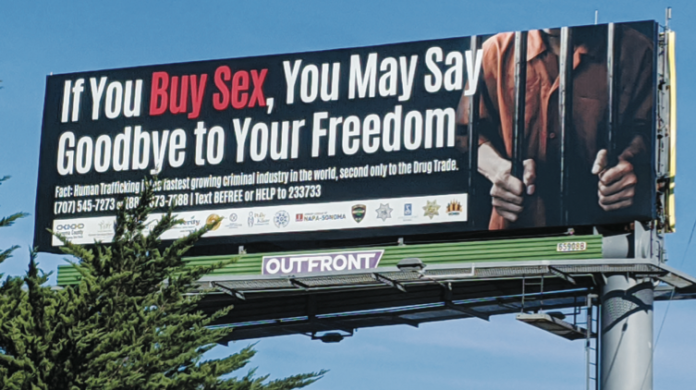Sonoma County residents don’t appreciate the scale of a crime happening all around them, despite an increased effort at public outreach over the past decade, according to a local nonprofit director.
“Human trafficking happens every single day in Sonoma County,” says Christine Castillo, the executive director of Verity, a Sonoma County nonprofit that offers services and support to trafficking victims and sometimes coordinates with law-enforcement agencies conducting enforcement operations.
Human trafficking, which requires the use of force, fraud or coercion to obtain some type of labor or commercial sex act, is a multibillion-dollar international industry. The worldwide problem is far more prevalent locally than most Sonoma County residents realize, Castillo says.
“Many people in our county just don’t understand. Many people think it’s a foreign problem, that it’s ‘over there,'” Castillo, who has worked at Verity for 13 years, says.
Due to the nature of the crime, it tends to be more difficult to enforce than drug dealing, the largest category of international crime.
While drug dealers are often caught holding hard evidence, human-trafficking victims may be coerced or threatened into telling law-enforcement officers that they are with their trafficker willingly, Castillo says.
But, despite the lack of general recognition—or maybe because of it—the human-trafficking industry is booming across the country, Castillo says.
As a result, government agencies and nonprofits are partnering to spread awareness about the issue.
In 2012, President Barrack Obama designated January as National Slavery and Human Trafficking Awareness Month. Each year, nonprofits and government agencies attempt to draw attention to the scale of human trafficking—and the resources available to victims—with press releases, advertisements and billboards.
Last week, multiple North Bay law-enforcement agencies announced recent programs targeting human-trafficking operations.
The Santa Rosa Police Department partnered with Homeland Security Investigations, the Federal Bureau of Investigation, the Petaluma Police Department, the Rohnert Park Department of Public Safety, the Healdsburg Police Department, Sonoma County Probation and VERITY, a nonprofit focused on human trafficking.
All told, the detectives contacted six women victims and arrested two men—one suspected of trafficking, the other of aiding and abetting the effort.
In their operation, the Santa Rosa Police Department attempted to offer support services to all of the victims, according to a press release.
In 2018, the National Human Trafficking Hotline received 1,656 reports of human trafficking in California. The vast majority of the cases—1,226 of the total—were for sex trafficking; 169 cases involved unspecified kinds of trafficking; and 151 cases involved labor.
In 2017, the national hotline recived notification of 6,244 cases of sex trafficking, a 13 percent jump from 2016.
County-level data is more difficult to come by. Arrest rates by law enforcement offer a hint but don’t offer the full picture since a large amount of trafficking goes undetected.
The Sonoma County District Attorney’s Office pursued 200 human-trafficking cases between 2011 and 2018.
In January 2019, the courts sentenced David Romesburg, a Rohnert Park man, and his mother for running a prostitution ring involving dozens of women over a period of 10 years, according to prosecutors.
“It is fitting that today’s sentence was handed down during Human Trafficking Awareness Month,” Sonoma County District Attorney Jill Ravitch said in a statement at the time. “The problem of sex trafficking is not exclusive to (the) Third World and large urban settings. It can and does happen in this community.”
In addition to supporting the increased attention and resources allocated towards solving the problem, Castillo and other advocates also support changes in the language used to describe trafficking operations—and the people law-enforcement agencies target.
For instance, Castillo says urges law-enforcement agencies not to arrest or ticket trafficking victims.
“What’s the point?” Castillo says.
Victims likely won’t be able to pay the fine or show up for a court date, she points out. Instead, law enforcement should target traffickers and offer support to victims. Local agencies are moving in this direction, she says.
In the Santa Rosa operation last week, the six trafficking victims were not cited, according to the police department’s press release.
Local goups coordinate their efforts through the Sonoma County Human Trafficking Task Force (SCHTTF), a group of which meets monthly and attempts to coordinate law-enforcement efforts with recovery-service providers.
When Super Bowl 50 came to San Francisco in 2016, law enforcement increased its efforts, anticipating an increase in prostitution as fans flooded into the Bay Area ahead of the big game.
This trend happens like clockwork every year, no matter where the Super Bowl takes place. Last year, when the game was held in Atlanta, government agencies ramped up enforcement and outreach efforts, although they acknowledged that trafficking was a year-round problem.
However, there is no evidence to support the media-fueled idea that trafficking increases significantly with big sports events like the Super Bowl, representatives of the Polaris Project and International Human Trafficking Institute told CNN last February.
The slight uptick in calls to the Trafficking Hotline is in part due to the fact that nonprofits and law-enforcement agencies tend to increase their outreach efforts during large events, including the Super Bowl.
In fact, trafficking happens throughout the country all year round, FBI spokesperson Kevin Rowson told CNN last February.
“The problem exists not just at major sporting events but throughout the year in communities all around the country,” Rowson said.











